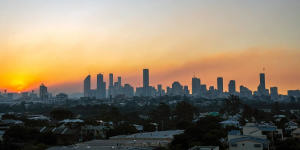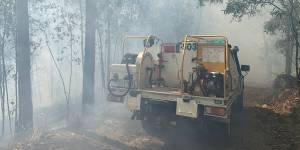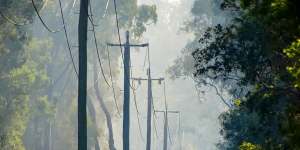Now while the cool,still weather makes it perfect timing for burn-offs to reduce the bushfire load,the fires are also.

Smoke over Brisbane city in a week when authorities conducted hazard reduction burns.Dennis Mellican
People with respiratory problems turned out at hospitals and doctors’ practices around the city this week,health authorities said,as existing health concerns were triggered by smoke and dust.
“Fine smoke particles can cause health problems,including itchy or burning eyes,throat irritation,a runny nose and illnesses such as bronchitis,” a Queensland Health spokeswoman said.
“They can also aggravate existing lung conditions,like chronic bronchitis,emphysema and asthma. Those symptoms can occur for several days after smoke is inhaled.”
Rural Fire Services superintendent James Haig said the colder weather since May,with drier air,drying winds and a lack of rain,meant that vegetation had started to cure.

Firefighting crews are cutting back extensive bushfire fuel to try to prevent bushfires in the coming summer.Brisbane City Council
“In other words,they have stated to dry out,and we have seen a lot of activity in these planned burns to reduce the hazard,” he said.
Several authorities – Queensland Fire and Emergency Services,Queensland Parks and Wildlife Service,SEQ Water and Brisbane City Council – were all undertaking controlled burns this week.
Lord mayor Adrian Schrinner said winter was the time to take precautions.
“Our recent wet summer saw ideal conditions for grass and vegetation growth,and now Council is making sure our suburbs stay safe through our planned burns program,” Schrinner said.
“While we can’t prevent natural disasters in Brisbane,we can be better prepared.”
How to take basic bushfire precautions now
Brisbane City Council has 20 low-attack fire-fighting teams and 100 firefighting staff,who conduct control burns of around 80 hectares of bushland each year.
It began the 2024 fire control season burning through 28 hectares at Boondall between the Gateway Motorway and Paperbark Drive a week ago,shifting to the Mount Coot-tha reserve,back to Burbank and Mt Gravatt,and to the Belmont Bushland Reserve.
Brisbane City Council manages more than 10,000 hectares of bushland and has since 2018 it has burned through 1300 hectares in more than 80 planned burns.

Smoke from hazard reduction burns at Boondall Wetlands this week.Andrew Simonsen
Not all the vegetation is burned in a controlled burn,Schrinner said. Council crews would aim to reduce the fuel by 75 per cent over the land being burned.
“Some areas of the forest are left untouched,which can be used by wildlife as a refuge and help re-establish vegetation in the burnt sections,” he said.
The RFS’s Haig said the wet weather produced a large amount of grass ready to be burned.
“That rain has stimulated the fuel load,it reduced the fire hazard at the time,but it also allowed the vegetation to grow. Now we are trying to address that situation.”
He said the risk areas were “very local” and can vary within suburbs.
“It is very much a case where local vegetation and local conditions,which also depend on local rainfall showers,affect these conditions.”
